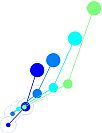Theory of mind (ToM) is a cognitive ability to build a dynamic mental model of another person in order to anticipate and predict her next decision. This scores from making predictions about others' choice (first level; ToM1) to simulate what other thinks about you (higher level, ToM2 aka recursive). Previous studies have shown that level of mentalization affected by the different context and some even suggest that the ToM level adjusts dynamically depending on the interactional context. For example, in competitive situations, individuals may engage a higher level of ToM to to estimate how an opponent would respond to my own choice and then counter her choice strategies, whereas during cooperative interactions that require coordination, an mental model that can just anticipate a partner's actions (without recursively responding to my own choice) may suffice. However, no study tested what happens in an environment, in which the interactional context changes dynamically.
To address this issue, we developed a new Social Foraging Task (SFT), where dyads of human participants are free to coordinate and choose between different three Islands to obtain rewards and play either a cooperative (Stag Hunt), a competitive (Matching Pennies), or an independent game, in which the my opponent's choice does not affect my own outcome. As in other foraging environments, each island has a total amount of resources that diminish over time as the players engage in the island's game and that regrow when they switch to another island. If the participants do not select the same island they will lose points. The task dynamics thus encourage the participants to coordinate on the patch decision and dynamically switch between islands to maximize joint otucomes. Using this task in an online study with 74 dyads, we are investigating whether ToM reasoning processes are maintained or change between different contexts.
In a first analysis we aimed to identify the task-related information that the participants used for their patch selecting choice. We therefore used the island with the highest resources, the partcipant's own and their opponent's previous choices, the relative island scores, and whether the previous choice resulted in coordination, and the total score from the previous trial as predictors in a multinomial regression analysis. This resulted in the identification of several choice strategies: Source Strategy: Players exclusively selected the island with the highest scores. 2. Source Strategy Plus Travel Cost: Players considered both the maximum patch score and the associated travel costs. 3. Preference Strategy: Players displayed a strong preference for certain patches (e.g. cooperative, independent) over others (competitive). Some players also employed a combination of these strategies. Additionally, we also observed a leader-follower dynamic in certain pairs during non-coordinated trials: when participants initially choose divergent islands, this dynamic helps them to realign their decisions and coordinate in subsequent trials, facilitating coordination and mutual reward. This suggests that getting out of non-coordinated trials may require higher levels of ToM, as players must anticipate and adapt to each other's choices to achieve alignment.
During the game decision, we compared the compared strategies between cooperative and competitive patches. In the cooperation mode, participants predominantly adopted a strategy of selecting the highest-reward options. conversely, in competitive scenarios, strategies were more varied, encompassing approaches such as "win stay lose shift," imitation, and entropy maximization. This finding demonstrates that participants adopt a larger variety of lower lever strategies and that the resulting higher level responses exhibit a differential response to theit opponent's strategies.
Using a newly developed computational model of recursive ToM we will estimates beliefs about the co-player at each levels of the ToM hierarchy. Unlike existing ToM models, our approach dynamically updated the choice strategy at the lowest level (L0) on which higher ToM levels are built. The preferred ToM level is estimated based on updating believes about the L0 using a Dirichlet distribution. Using this model allows us to investigate whether different interactional contexts elicited changes ToM levels or whether they remained constant during context switches.

 PDF version
PDF version
